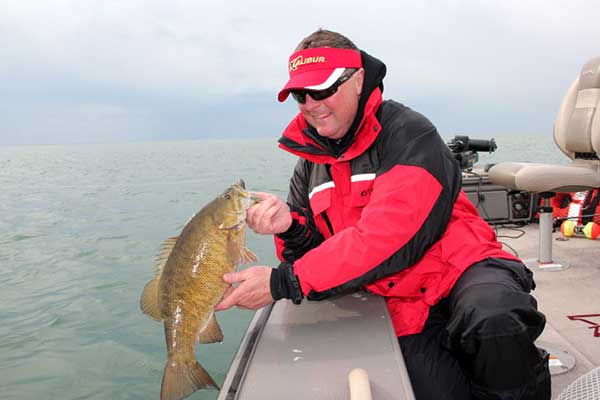- Details
Check out the photos of Al Tucker, Louie Stout, Jon Howard, and Jeremy Bunnell taken during our northern Michigan smallmouth adventure. The fish were moving up to spawn and it was game on! On one day, we had 70 smallmouth with at least 1/3 of them over 5 pounds!
Click the small images for a larger view.
- Details
By Abe Smith
(Provided by PRADCO Lures)
 Great Lakes Areas For Fall Smallmouth BassGreat Lakes smallmouth bass provide some of the hottest bass action of the year during the fall. As their name implies, the challenge on these waters derives from their magnitude. Fish have plenty of room to roam from Duluth to the St. Lawrence River, and “roaming” is part of a smallmouth’s daily life.
Great Lakes Areas For Fall Smallmouth BassGreat Lakes smallmouth bass provide some of the hottest bass action of the year during the fall. As their name implies, the challenge on these waters derives from their magnitude. Fish have plenty of room to roam from Duluth to the St. Lawrence River, and “roaming” is part of a smallmouth’s daily life.
Here are three great Great Lakes fishing spots and how to catch them:
Lake Erie and Niagara River (Buffalo, Niagara, and Lewiston, N.Y.)
“In fall, it’s all about bait,” says Frank Campbell, a guide with Niagara Region Charter Service.
Campbell is considered by many to be the “dean” of an illustrious school of smallmouth guides on the Eastern Basin of Lake Erie and the Niagara River near Buffalo, New York. He says that smallmouth are looking for the quickest way to bulk up for winter and follow baitfish migrations and eat everything they find, from gobies to crayfish to sculpin to emerald shiners…anything that brings protein to their diet.
- Details
(Provided by Plano Molding)
 KVD tells what it takes to win at St. ClairThere’s a reason Kevin VanDam (KVD) is the all-time money winner ($5,499,476.33 to date, to be exact) on the Bassmaster Tournament Trail: The 45-year-old, 7-time “Angler of the year” knows how to boat bass of all species better than anyone else on earth – and numbers don’t lie.
KVD tells what it takes to win at St. ClairThere’s a reason Kevin VanDam (KVD) is the all-time money winner ($5,499,476.33 to date, to be exact) on the Bassmaster Tournament Trail: The 45-year-old, 7-time “Angler of the year” knows how to boat bass of all species better than anyone else on earth – and numbers don’t lie.
And that’s why we interrupted the Plano prostaff’s pre-fishing before his last tournament of the year, the 2013 Elite Series Plano Championship Chase on Lake St. Clair/Detroit River.
It’s all to bring you KVD’s first-person and private (well… until now) look at this phenomenal fishery and what it’s going to take to win the $100,000 purse at the end of the three-day event. And best of all, KVD—who’s now in third and verging on his eighth “Anger of the Year” title—was more than willing to answer our inquiries.





